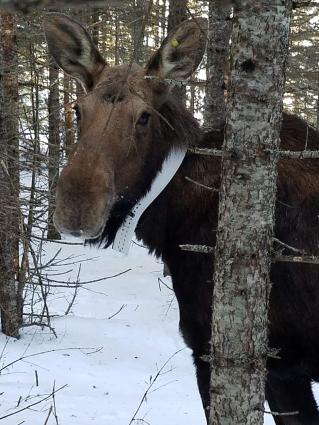LSProject: Researchers to compare Isle Royale, Grand Portage Moose populations
The University of Minnesota’s College of Veterinary Medicine and the Grand Portage Band of Lake Superior Chippewa have partnered to conduct an interesting study of the moose populations in our region.
The purpose of the study is to compare mainland and island moose populations—the moose here on the North Shore of Minnesota and on Isle Royale, about 15 miles away on Lake Superior.
Following the reintroduction of several collared wolves from Grand Portage to Isle Royale National Park last fall, and an additional six from Canada in the last month, a team of researchers have collared a number of moose on the island.
Click below to find interviews with two of the scientists involved in this study, Dr. Tiffany Wolf of the University’s Veterinary Medicine College and Dr. Seth Moore, Director of Biology and Environment for the Grand Portage Band of Lake Superior Chippewa. Join Rhonda Silence as she learns more.
Photos courtesy of Dr. Seth Moore, Director of Biology and Environment for the Grand Portage Band of Lake Superior Chippewa.
Support for this series comes from the Minnesota Arts and Cultural Heritage Fund.
Additional background is provided in this news release from the partner agencies:
ISLE ROYALE NATIONAL PARK, MICHIGAN --- Following the reintroduction of several collared wolves from the Grand Portage Indian Reservation to Isle Royale National Park last fall, a team of researchers have now collared moose at the park for the first time since 1984. A unique collaboration between the University of Minnesota College of Veterinary Medicine (CVM), National Park Service, Michigan Technological University, and Grand Portage Band of Lake Superior Chippewa aims to help the National Park Service assess the impacts of predator restoration to the ecosystem at the park.
This effort marks the beginning of a novel effort to compare the predator-prey dynamics and health of the population of moose on Isle Royale National Park to a neighboring population of collared moose on the mainland on the Grand Portage Indian Reservation. It also represents an opportunity to evaluate the impact of restoring predation to the ecosystem.
Between February 13-17, 2019, a helicopter anesthesia darting team, a wildlife veterinarian, and wildlife research biologists fitted 20 cow moose with GPS collars on the west and east sides of the island. The team collected biological samples from the anesthetized moose, assessing individual moose health, and fitting them each with a collar. Afterward, each moose was administered a reversal drug—they all awoke and walked away in under two minutes. Since then, movement activity has been continuously monitored by GPS.
The team plans to conduct various studies with the data they have collected. They are looking to understand what impacts health of moose populations on both the mainland and Isle Royale, how predator dynamics play a role in moose populations, how differing forest management affects the ecosystem, and how climate may play a role in ecosystem health.
Contrasting ecosystems
Isle Royale hosts a simple ecosystem with one predator species, wolves, and one primary prey species, moose. This makes it an ideal system for comparative research with mainland populations of moose, such as those found on the Grand Portage Indian Reservation, which hosts a more complex ecosystem with multiple predators and multiple prey species. Mainland populations of moose are in decline due to predation from bears and wolves on moose calves in early spring, as well as compounded effects of climate change, which includes parasitism from brainworm (transmitted by the invasion of whitetail deer into moose range), and high winter tick loads due to early snow melt.
By contrast, the moose population on Isle Royale has increased rapidly in recent years. Although moose in Isle Royale also suffer from high winter tick loads, the Isle Royale population of moose does not have deer to transmit brainworm. Another crucial difference is that wolf numbers are high on the mainland (due to high deer densities), whereas the island only has a few remaining wolves predating on the moose population.
Over the last two decades, the island’s wolf population suffered from inbreeding depression that drove the population to the brink of extinction. That circumstance is an indirect consequence of climate change, which led to fewer ice bridges forming between island and mainland, preventing wolves from moving to and from the island. The impact of the growing moose population on forest vegetation is increasingly apparent and experts are concerned that such high levels of browsing damage are impacting forest regeneration and may eventually lead to nutritional stress for moose.
The contradictory population trajectories between Isle Royale’s wolves and moose and those on the mainland create an ideal opportunity to better understand by comparison what ecological factors are impacting each population. “This is a unique opportunity to explore the health of a species through the comparison of two populations under a different set of pressures alongside experts from different scientific disciplines and with their own distinctive skillsets,” says Tiffany Wolf, DVM, PhD, assistant professor in the Veterinary Population Medicine Department at the CVM. Wolf is one of many collaborators on the project. “That kind of collaboration brings research to the next level and affords the opportunity to attain new insights into population health that might otherwise not be realized.”
Decades in the making
Grand Portage Band has more than 250 years of stewardship of Isle Royale. UMN has conducted research on wolf-moose interaction on the island for 45 years. UMN and Grand Portage have been collaborating to study moose health and habitat use since 2009.
The decade-long partnership has since expanded to explore other aspects of health related to species important to the Grand Portage Band of Chippewa.
Tweet







